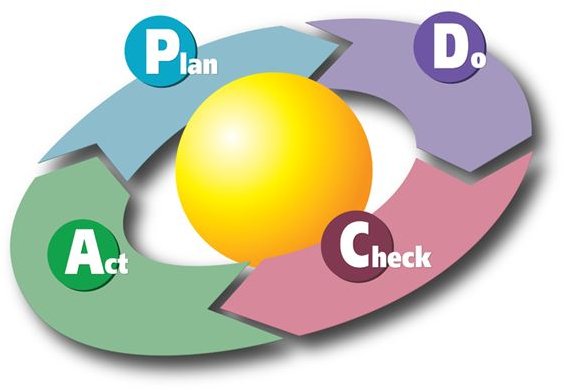5 Major Uses of Plan-Do-Check-Act (PDCA)
The Plan-Do-Check-Act (PDCA) model is a flow diagram for learning and for improvement of a product and a process. It works on a simple concept of planning the required changes (plan), making the changes (do), checking whether the implemented changes have the desired effect (check or study), and institutionalizing the changes (act.)
W. Edwards Deming, the pioneer of the modern-day plan-do-check-act (PDCA) cycle, advocated its use as a process improvement and quality management tool.
The resilience of PDCA for practice at any level or magnitude has contributed to its development as one of the the most popular and evergreen process improvement methodologies, besides extending its use to several other purposes.
Process Improvement
The PDCA methodology is a continuous loop of planning, doing, checking or studying, and acting. This makes PDCA the ideal model for:
- Continuous improvement: The repeated PDCA cycle drives forward process improvement irrespective of the goals and shuts the door on complacency
- Implementation of new projects or processes: The inbuilt plan, test, and feedback mechanism of PDCA allows fixing snags and improving things at the process implementation stage, without putting entire resources or reputation at stake.
- Process trails: The PDCA cycle entails checking the implemented changes for consistency before adopting it across the board
Utilizing the plan-do-check-act cycle allows breakdown of a project into small manageable steps and allows gradual incremental improvements.
Change Management
PDCA not only encourages development of innovative and breakthrough changes to ensure quality and performance improvement, it also help manage change effectively.
The PDCA model incorporates what needs changing to the methodology of continuous improvement. The change process under PDCA entails incorporating the parameters that require change in the planning component (plan), implementation of a prototype (do), the review of the prototype for suitability and performance (check or learn) and widespread implementation or successful implementation of the prototype (act). This contributes to integrating the change management process within the normal day-to-day organizational activity, making the change process seamless.
Quality Management
One of the major uses of this process is for quality management. The continuous feedback loop of PDCA allows analysis, measurement, and identification of sources of variations from customer requirements and enables taking corrective action.
PDCA is the popular tool for implementing Total Quality Management, and it is the basis for the Six Sigma DMAIC initiative. The implementation of such quality systems depend on the statistical analysis and control that PDCA facilitates. The application of PDCA for quality improvement helps plan data collection and undertakes statistical analysis of the data to verify and prioritize problems or root causes of issues. It identifies the means to reduce the deviation between the existing state and the desired state.
Maintaining Control over a Project
The PDCA model helps project managers maintain greater control over a given project in many ways, such as:
- Providing answers to the who, what, when, where, and why of the project. This increases knowledge that makes it easy to explore various alternatives and select a suitable method of project implementation.
- Ensuring that the unknowns at the start of the project remains either proven or discounted.
- Providing of accurate and timely data to improve decision-making.
- Enabling a better understanding the cost and effect phenomenon.
Performance Management
One recent use of Plan-Do-Check-Act is in performance management of individual employees and project teams on a daily routine basis. The “plan” phase incorporates the targets or deliverables for the employee or team. The “do” phase is the actual performance, and the “study” phase reviews the performance. The “act” phase confirms such performance.
In most organizations performance management–or its older performance-appraisal version–remain a distinct “staff” function. The PDCA approach toward performance management integrates performance management with the day-to-day operational activity and contributes to improving productivity in a big way.
Organizational Competitiveness
The application of the PDCA cycle helps the organization become agile or incorporate closed-loop management with speed.
Agile PDCA entails identifying sources of variability and their relative negative impacts, and eliminating or reducing such variabilities wherever possible by changing supply chain design, policies, or business rules. Contingency plans are developed that handle the risks that remain.
The process also helps integrate the functioning of demand management, supply management, fulfillment management, rapid business reconfiguration, and IT systems in an organization.
Such dealing with variability and improving coordination among various processes speeds up business cycles, increasing the organization’s competitiveness.
References
- American Society for Quality. Plan–Do–Check–Act Cycle. https://www.asq.org/learn-about-quality/project-planning-tools/overview/pdca-cycle.html
- Mindtools.com. Plan-Do-Check-Act (PDCA). https://www.mindtools.com/CXCtour/PDCA.php
- International Community for Project Managers. The PDCA Cycle of Systematic Development. https://www.theicpm.com/quality-management/3413--the-pdca-cycle-of-systematic-development
- Najmi, Adeel & Sidhu, Sanjiv. Creating Greater Agility with Plan-Do-Check-Act. https://www.i2.com/supplychainleader/issue3/html/SCL3_creating_greater_agility.cfm
Image Credit: Wikimedia Commons, PDCA Cycle by Karn G. Bulsuk
